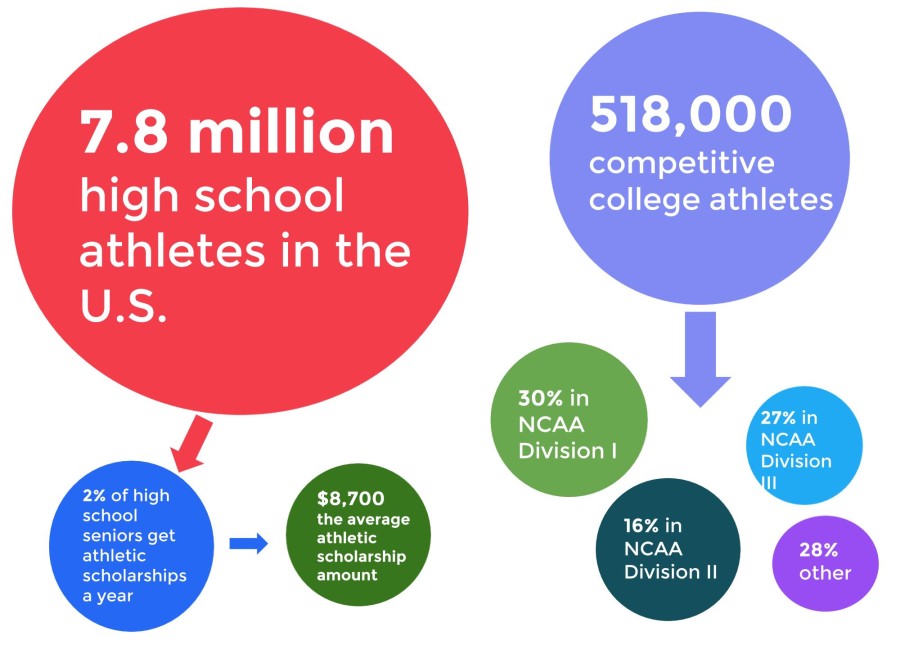The harsh reality of college sports: opportunities are few and far
December 16, 2015
An overwhelming 46 percent of all high school students play high school sports across the nation; however, only 6.5 percent of all high school students go on to play sports at a competitive collegiate level.
For many of us who play both high school and club sports, that can be a dream-crushing statistic. The realities of college sports and scholarships are like a hard punch in the face, which brings to question: why are any of us doing all of this?
We (myself included) devote hours upon hours of our lives to our sport, we invest hundreds, thousands, even tens of thousands of dollars to run around playing on travel teams, buying equipment, and countless other expenses. For a large number of athletes, the mentality is that if we allocate large amounts of money and time, we will certainly be guaranteed to play in college. But that’s just not how it is, unfortunately.
So many athletes and their families get too caught up in the dream to realize the sensibilities of their aspirations. We’re doing all of this, but nothing is guaranteed. Not a single one of us is guaranteed a spot on a college team or a large scholarship. Despite the harsh truth within that statement, I’ve met many athletes and teammates with the mentality that they would surely receive a full-ride scholarship for their sport, so why should they focus on academics or any other type of extracurricular? The illusive nature of collegiate sports seems to become the obsession of many families, but the truth is really in the numbers. Two percent of all high school athletes receive any athletic scholarship at all, and a microscopic amount of athletes receive full rides—just under 0.9 percent.
This recent revelation of mine made me seriously look at the reasons behind my tireless drive to keep playing more and more of my sport.
What I’ve come to realize is that there is so much more to playing sports than getting recruited or receiving huge scholarships. As athletes, we should not build the entire basis of our sports careers on the extrinsic value; instead, we should focus on what we get out of it.
I spend an average of 26 hours a week during the summer on a softball field, and there is no offseason. Every weekend from May to August is spent either on a softball field or in commute to a softball tournament with my travel team, and the remaining months of the year are spent playing Sequoia softball or continuing practicing in the winter months. My household spends hundreds of dollars on equipment, fees, hotels and gas annually to satisfy my athletic interest.
It all started ten years ago with a love for the game that sparked into a passion. Like so many other teenagers in the country, I love the sport I play. As I progressed into my mid-teens, the thought of college became less of a distant idea and more of a cloud looming ominously over my head.
Suddenly I had people asking me “have you started recruitment yet?” or “where are you looking at playing in college?” and I had no answer. I was surrounded by people prematurely planning out their futures of playing starting positions for huge Division I schools or getting full ride scholarships, but I knew deep down that it was all too good to be true. How could all of those people defy the statistics, how could they all do the nearly impossible?
Even with odds stacked against us, we persevere. The statistics are discouraging to say the least, but the importance and value of playing sports as a teenager should not be held in the hope of getting a large scholarship or going on to play in college. I do not get up at 4 a.m. every weekend during the summer because I think it will guarantee me a starting spot on Stanford’s softball team. I do not devote my blood, sweat and tears to my sport because I think it will get me a full ride scholarship. I am committed to my sport for the love of the game, and I know that the majority of the 7.8 million high school athletes are also committed because of their love of the game.
The idea of playing in college is still real to me, I have just learned to tread carefully when planning my future and my decisions. I have not given up on it; instead, I have adapted to reality. I have learned to find balance in my life and value academics as equally as I do athletics. For the other 93.5 percent of athletes who will not get recruited, your time and money spent playing sports has not been wasted. There is so much to value in playing sports and so much available to benefit each athlete. To me, sports have toughened me mentally in ways that carry over into the classroom and other aspects of my life. Sports have caused me physical, mental and emotional pain, yet have given me some of the most rewarding moments in my life; sports have supplemented tools to make me a well-balanced person, and these lessons will carry throughout the rest of my life— even when I’m older and no longer playing, I will still hold within me the value of sports regardless of whether or not I go on to play in college or receive athletic scholarships.







